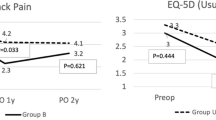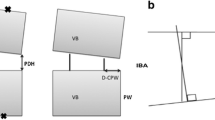Abstract
The authors conducted a study to determine at what stage after surgery the subsidence occurred, and to assess the relationships of radiographic fusion and the recurrence of symptoms with the development of subsidence. Ninety patients underwent a single-level anterior lumbar interbody fusion (ALIF) using paired stand-alone rectangular cages between November 2000 and June 2002. All patients had regular clinical or imaging follow-up for a minimum of 19 months (range 19–38 months, mean = 27 months). The ratio of male to female patients was 1:3.1. The patients’ ages at the time of ALIF ranged from 25 to 72 years, with a mean of 53 years. The preoperative and postoperative intervertebral disc heights were serially measured by plain radiographs. The location of cage subsidence into the vertebral body and times until the presence of subsidence were also assessed. The mean preoperative intervertebral disc height was 11.6±3.1 mm, which spread immediately after surgery to 16.9±2.0 mm. This increase was statistically significant (P=0.001). At the last follow-up visit, the mean intervertebral disc height had been reduced to 13.2±2.4 mm. Sixty-nine of 90 patients (76.7%) developed cage subsidence into the surrounding vertebral body. Subsidence was more often noted in the superior endplate above the cage with regard to the location of cage subsidence [superior endplate: 27 patients (39.1%), inferior endplate: 12 patients (17.3%), both: 30 patients (43.6%)]. The onset of subsidence varied from 0.25 to 8 months after surgery (median, 2.75 months). The 8-, 12-, and 16-week actuarial rates for developing cage subsidence were 38.9, 63.4, and 70.7%, respectively, when using the Kaplan–Meier method. There was no statistical correlation between the recurrence of symptoms (P=0.3952) and radiographic fusion (P=0.9518) with the log-rank test in development of subsidence. This study demonstrates that cage subsidence is an expected occurrence after ALIF using stand-alone rectangular cages. The 3- and 4-month actuarial rates for developing cage subsidence were 63.4 and 70.7%, respectively, and cage subsidence had no correlation with recurrence of symptoms and radiographic fusion in our study.





Similar content being viewed by others
References
Bak KH, Kim YS, Kim JM, Kim CH, Koh Y, Oh SH, Oh SJ, Kim KM, Kim NK (1998) Minimally invasive anterior lumbar interbody fusion (in Korean). J Korean Neurosurg Soc 27:792–799
Blumenthal SL, Baker J, Dossett A, Selby DK (1988) The role of anterior lumbar fusion for internal disc disruption. Spine 13:566–569
Brantigan JW, Steffee AD (1993) A carbon-fiber implant to aid interbody lumbar fusion: two-year clinical results in the first 26 patients. Spine 182:106–2117
Bridwell KH, Lenke LG, McEnery KW, Baldus C, Blanke K (1995) Anterior fresh frozen structural allografts in the thoracic and lumbar spine. Spine 20:1410–1418
Cheung KM, Zhang YG, Lu DS, Luk KD, Leong JC (2003) Reduction of disc space distraction after anterior lumbar interbody fusion with autologous iliac crest graft. Spine 28:1385–1389
Choi JY, Jeong HT, Hyun YI, Sung YS, Lee YS, Sung KH (2004) A retrospective study of the fusion rate and clinical outcome after mini-open ALIF using paired stand-alone rectangular cages (in English). J Korean Neurosurg Soc 36:28–33
Dennis S, Watkins R, Landaker S, Dillin W, Springer D (1989) Comparison of disc space heights after anterior lumbar interbody fusion. Spine 14:876–878
Grant JP, Oxland TR, Dvorak MF (2001) Mapping the structural properties of the lumbosacral vertebral endplates. Spine 26:889–896
Inoue S, Watanabe T, Hirose A, Tanaka T, Matsui N, Saegusa O, Sho E (1984) Anterior discectomy and interbody fusion for lumbar disc herniation: a review of 350 cases. Clin Orthop 183:22–31
Kumar A, Kozak JA, Doherty BJ, Dickson JH (1993) Interspace distraction and graft subsidence after anterior lumbar fusion with femoral strut allograft. Spine 18:2393–2400
Onimus M, Papin P, Gangloff S (1996) Extraperitoneal approach to the lumbar spine with video assistance. Spine 21:2491–2494
Oxland TR, Grant JP, Dvorak MF, Fisher CG (2003) Effects of endplate removal on the structural properties of the lower lumbar vertebral bodies. Spine 28:771–777
Roberts S, McCall IW, Menage J, Haddaway MJ, Eisenstein SM (1997) Does the thickness of the vertebral subchondral bone reflect the composition of the intervertebral disc? Eur Spine J 6:385–389
Sandhu HS, Turner S, Kabo JM, Kanim LEA, Liu D, Nourparvar A, Delamarter RB, Dawson EG (1996) Distractive properties of a threaded interbody fusion device: an in vivo model. Spine 21:1201–1210
Soini J (1994) Lumbar disc space heights after external fixation and anterior interbody fusion: a prospective 2-year follow-up of clinical and radiographic results. J Spinal Disord 7:487–494
Steffen T, Tsantrizos A, Aebi M (2000) Effect of implant design and endplate preparation on the compressive strength of interbody fusion constructs. Spine 25:1077–1084
Weiner BK, Fraser RD (1998) Spine update lumbar interbody cages. Spine 23:634–640
Author information
Authors and Affiliations
Corresponding author
Rights and permissions
About this article
Cite this article
Choi, J.Y., Sung, K.H. Subsidence after anterior lumbar interbody fusion using paired stand-alone rectangular cages. Eur Spine J 15, 16–22 (2006). https://doi.org/10.1007/s00586-004-0817-y
Received:
Accepted:
Published:
Issue Date:
DOI: https://doi.org/10.1007/s00586-004-0817-y




